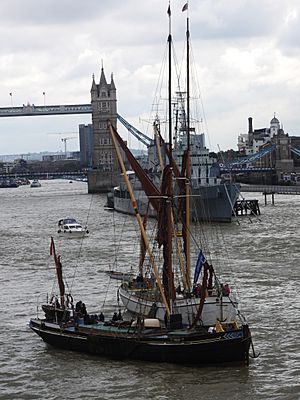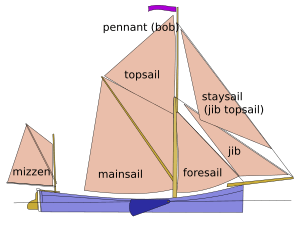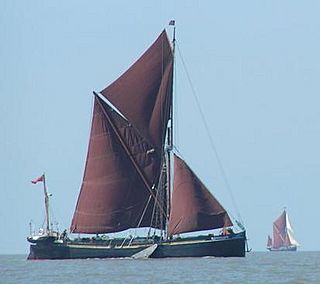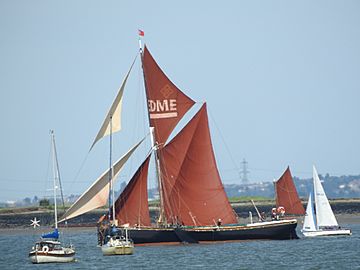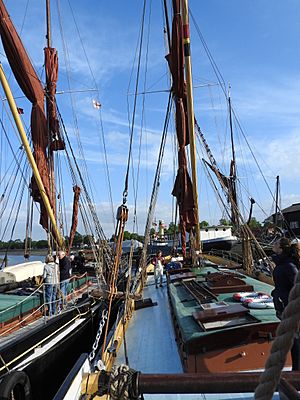SB Centaur facts for kids
class="infobox " style="float: right; clear: right; width: 315px; border-spacing: 2px; text-align: left; font-size: 90%;"
| colspan="2" style="text-align: center; font-size: 90%; line-height: 1.5em;" |
|}
SB Centaur is a special wooden Thames sailing barge. She was built in Harwich, England, way back in 1895. For 60 years, she worked hard carrying different goods, mostly grain.
During the First World War, she helped by taking food and coal to French ports. In the Second World War, Centaur was damaged while trying to help with the Dunkirk evacuation. She then continued to do important war work.
After the war, she went back to carrying grain until 1955. Then, her sails were taken down, and she was used as a lighter (a boat that moves goods short distances) until 1966. That year, Richard Duke bought her and put her sails back on to use her for tours. In 1973, a charity called the Thames Barge Sailing Club (now the Thames Sailing Barge Trust) bought her.
Centaur was carefully restored between 1984 and 1993, and again in 2013. Today, she rests at Hythe Quay in Maldon.
Contents
| History | |
|---|---|
| Name | Centaur |
| Owner |
|
| Builder | J & H Cann (Harwich) |
| Commissioned | 1895 |
| Status | Private use and private charter ship |
| Notes | 99460 |
| General characteristics | |
| Tonnage | 61 |
| Length | 85.6 ft (26.1 m) |
| Beam | 19.55 ft (5.96 m) |
| Height | 80 ft (24 m) to top of topmast |
| Draught | 6.2 ft (1.9 m) distance between the waterline and the bottom of the hull (keel) |
| Propulsion | Sails and auxiliary diesel engine |
| Notes | Wood |
What is a Thames Sailing Barge?
Thames sailing barges were large sailing vessels that were very common on the River Thames in London. These boats had flat bottoms and a shallow draught (meaning they didn't sit very deep in the water). They also had leeboards, which are large wooden boards on the sides that could be lowered into the water. These features made them perfect for the shallow, narrow rivers and waters of the Thames Estuary and East Anglia.
Even though they were large, the biggest barges could be sailed by just two people! Most barges were about 120 tons and had huge sails, covering about 3,000 to 5,000 square feet.
- The mainsail was a big sail that could be folded up against the mast when not needed.
- The foresails were also easy to manage.
- The topsail was usually the first sail put up and the last taken down. It was fixed to the topmast (the highest part of the mast) with hoops. This sail helped catch wind high up, especially in calm areas near the water.
- The mizzen boom (a pole at the bottom of the mizzen sail) was connected to the long, shallow rudder, which helped the boat turn.
The sails were made from flax and got their reddish-brown color from a special waterproofing mix of ochre, fish oil, and even urine! The masts could be lowered using a special system called tabernacles and an anchor windlass. This allowed the barges to pass under bridges without stopping. Sometimes, helpers called "hufflers" would come aboard to help raise the mast for a fee. If a bowsprit (a pole sticking out from the front of the boat) was used, it could also be raised when space was tight.
These barges had wooden hulls (the main body of the boat) and were about 80 to 90 feet long. Their beam (width) was around 20 feet. The hull was mostly a large cargo hold, with small living areas at the front and back. There were two big openings on the deck to load cargo.
Thames barges didn't need ballast (heavy material to keep a ship stable) because of their design, which saved time when loading and unloading. Many barges later added engines, but originally, they relied only on sails. If there was no dock, a barge could wait for the tide to go out, settle on the mud near the shore, and unload its cargo directly into carts.
Sailing barges were quite fast, reaching speeds over 12 knots (about 14 miles per hour) in good conditions. Their leeboards helped them sail very well against the wind. The unique spritsail rig meant that different combinations of sails could be used, even just the topsail on its own!
What Did Barges Carry?
Thames sailing barges were like the big trucks of their time. They could move up to 150 tons of loose cargo at once into London. They brought in coal for factories, bricks for building homes, and hay for horses. Barges also carried rubbish from cities to brickfields, where it was used as fuel. Only the last mile of the journey to the brickfields needed road transport. In 1900, there were over 2,000 privately owned Thames sailing barges working!
Centaur's Journey Through Time
Building the Centaur
SB Centaur was built from wood, probably pitch pine on oak, for Charles Stone of Mistley. She was meant for coastal trade (carrying goods along the coast). Centaur was larger than most sailing barges and was known for her strong build, which made her very good at sea.
She was 85.6 feet long, 19.55 feet wide, and had a draught of 6.2 feet. She could carry 61 tons of cargo. When fully loaded, she sometimes had as little as 9 inches of freeboard (the distance from the water to the deck), and if loaded quickly, she might list (lean to one side).
It took only six weeks to build her! She was launched on February 15, 1895, by John and Herbert Cann in Harwich. Her first captain was James Stone, and she had a crew of two: a mate and a boy. Interestingly, there was another Thames sailing barge also named Centaur, built in 1899, which sank in 1930 after a collision. So, sometimes old records can be a bit confusing!
In 1898, Centaur won the Harwich Barge Race. She often carried wheat, hydrochloric acid, sugar, linseed oil, and raw linseed. In 1902, her steering gear was damaged, and in 1905, she had to be towed into port. In 1906, she lost both her anchors off the Netherlands.
People who sailed Centaur said she was a pleasure to handle. She sailed well against the wind and was easy to steer even in tight spaces. She was very balanced and needed little effort to steer. She could even carry her full set of sails in a strong wind (Force 5), though in rough seas, the captain would look for shelter if she was heavily loaded.
Centaur in World War I
During the First World War, SB Centaur joined other barges in carrying food and large amounts of coal and pitch to French ports like Le Treport, Calais, and Boulogne-sur-Mer. There were often 180 barges unloading at Le Treport! They could sail over enemy mines because they didn't sit deep in the water, and they were too small to be noticed by enemy submarines. These trips were very profitable.
One time, in thick fog, Centaur was hit in the middle by a small, fast military boat called a coastal motor boat (CMB). The CMB ended up on Centaur's main deck! Luckily, both boats were fine, and Centaur safely delivered both the CMB and her cargo.
Between the Wars
After the war, Centaur went back to carrying goods along the coast. She made many trips to France and Belgium with pitch and coal. Ephraim Cripps was her captain for twenty years and kept detailed records of every journey. From 1928 to 1930, Colchester was her main port, and she worked along the East Anglian coast. In 1933, she joined Francis and Gilders Ltd., a company that managed many sailing barges. They transported grain from Norfolk, Suffolk, and Essex into London.
Centaur in World War II
The Second World War began, and one of the first big events for civilian ships was the Dunkirk evacuation. Hundreds of small ships helped rescue Allied soldiers from the beaches of Dunkirk. Like many other sailing barges, Centaur sailed to the meeting point at Dover. But there, she accidentally crashed into a tugboat, which meant she couldn't make the crossing to Dunkirk. For the rest of the war, she worked for the government, carrying the same kinds of goods around the south and east coasts of England.
After the War
After the war, Centaur returned to carrying grain. In January 1952, during very strong winds and rough seas, her rudder broke. Another barge, the SB Saxon, had to tow her to safety.
Francis and Gilders Ltd. were known as "seeker barges" because they would look for any cargo they could carry. In 1951, they merged with the London and Rochester Trading Company. The new owners wanted to sell these barges, and Centaur carried her last cargo in 1955. In her final year of carrying goods, she transported timber, sugar beet, cement, and oil drums, as well as grain.
Centaur and the three other remaining working sailing barges were then taken out of service and sold to Brown & Son of Chelmsford. There, their masts were removed, and they were used as timber lighters (boats for moving timber). From 1955 to 1966, she helped move timber from large ships in the Blackwater estuary to smaller canal boats going to Chelmsford.
In 1966, Richard Duke bought her and put her sails back on to use her for charter trips (tours). In 1968, she won her class in the Blackwater Sailing Barge Match. In 1973, she was sold to the Thames Barge Sailing Club (now the Thames Sailing Barge Trust), which is a charity.
Centaur was restored between 1974 and 1993. Most of her wooden frame and planks were replaced, and a new engine was installed. In 1993, she won the Inter-match Trophy. In 1995, more parts of her hull were replaced. In 2013, she received a grant of £100,000 from the Heritage Lottery Fund for more restoration work, including strengthening her bottom timbers.
Today, she is docked at Hythe Quay in Maldon. As of 2018, she is available for charter during the summer months. She still has her traditional sails, just like she did in 1895, with about 2,600 square feet of sail!
Who Owned Centaur?
Here's a list of who owned Centaur over the years:
- 1895: Charles Stone
- Around 1900: Dolly Rogers
- 1911: Ted Hibbs
- 1915: John Sawyer
- 1933: Francis & Gilders
- 1951: London and Rochester Trading Company
- 1955: Brown & Co. (They took her sails off to use her for timber.)
- 1965: Richard Duke (He put her sails back on for tours.)
- 1973: Thames Barge Sailing Club, now the Thames Sailing Barge Trust.
These dates show when Centaur came under new ownership.
See also


